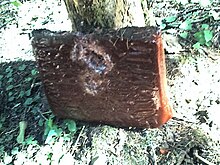Making an Island/Materials
Seacrete / Biorock / Mineral accretion
[edit | edit source]
By using a low electrical current and a metal mesh you can cause minerals to be deposited on the mesh. Rate of deposition is limited by current used, flow rate of water and many other variables. The minerals can grow at the rate of about 5 inches per year depending on the amount of current flowing. The higher the current (amps), the faster that accumulation occurs. This is a fairly environmentally-friendly technique as the only resources it requires that are not easy to provide from a renewable source is the mesh.
Of course, the electricity must also be considered and this will require a source. This could be provided by generators such as solar panels, wind generators, batteries, and the like, but these will require some kind of existing nearby structure or platform to be positioned on.
Concrete
[edit | edit source]Concrete is fairly commonly used by artificial island projects.
Concrete is not a particularly 'green' material, as concrete production releases a large amount of carbon dioxide.
Pikecrete/Pykrete
[edit | edit source]
Pikecrete is a compound invented by a British scientist named Geoffrey Pyke working under Lord Mountbatten during the Second World War. It consists of ice with 14% sawdust or wood pulp and 86% water mixed into a slurry and frozen. The resulting compound is not only roughly as strong as concrete, but also resists melting and is able to float, being less dense. It also does not suffer from concrete's carbon dioxide output issues.
History Lord Mountbatten threw a small block into Churchill's bath water as he rushed into his house and gave him the idea of building an aircraft carrier (HMS Habakkuk and sister ships) out of pikecrete. The ship would have been larger than anything before or since, and it could resist (unlike normal ships) torpedoes and bullets.
Supposedly, Lord Mountbatten demonstrated this by firing two rounds from his revolver--one at ice which was shattered, and then at the pikecrete which actually bounced off and nicked Admiral Ernest King in the leg, making his point.
Pikecrete theoretically only needs cooling pipes to keep it afloat in tropical waters. Aircraft carriers made of it would therefore have been able to stay afloat, only needing to go to the Arctic every few years for a complete re-freezing.
Currently As of today pikecrete/pykerete is not considered relevant by most scientists. Pykrete is generally only used for glacial reconstruction.
Steel and other metals
[edit | edit source]Steel hulls have some great benefits. It's readily available all over the globe, it's not prone to marine borers, it is quite cheap once you come up to a certain scale (some where around 7 meters in diameter for a circular island).
But it certainly has some backsides as well. Since sea water is inherently eroding on almost all metals, the steel has to be protected in some way. The obvious solution to the layman is of course different kinds of paints and varnishes. As one intuitively understands, this not an ecological way, and since it usually demands some re-applying every now and then you might have to see to that your island is capable of being dry docked. Another alternative of conservation, or more correct, for delaying the erosion, is using anodes. The two methods can be combined.
Plastics and ceramics
[edit | edit source]Artificial Islands have been made using recycled plastic bottles.
That said, plastics should be used with care. Erosion of plastic leads to micro plastics leaching into water, which has negative environmental impacts.